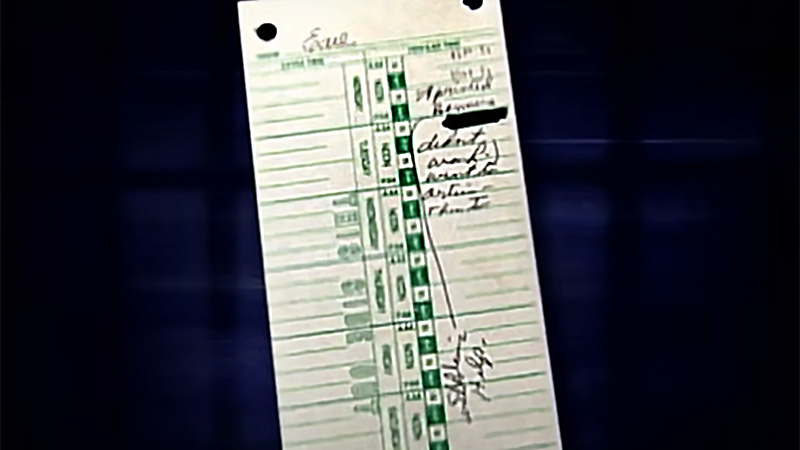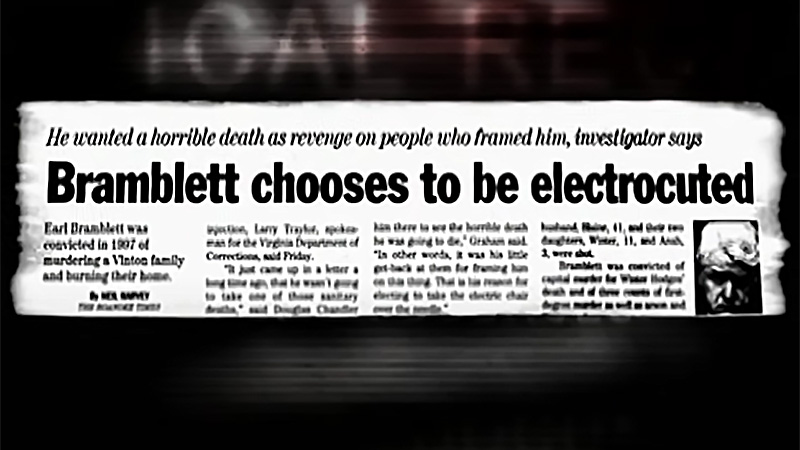Private Thoughts
Earl Bramblett murder of entire Hodges family
Finding the entire family deceased after a fire at the Hodges house pointed to a tragic murder-suicide. But investigators soon found evidence of something more sinister.
Original air date: August 26, 2004
Posted: February 5, 2022
By: Robert S.
Season 8, Episode 16
In 1994, first responders were alerted to an early morning fire at a house just outside of Roanoke, Virginia. Their worst fears were confirmed when they soon discovered that all members of the family in the home were deceased. But the blade hadn't destroyed the evidence that none of the victims had succumbed to effects of the fire – each had been killed before the fire even began
The four members of the Hodges family had met their fates in different rooms of the house. The adult female was identified as Theresa Hodges, and her body was found on the sofa downstairs. It appeared she had been strangled. The manner of death for the remaining Hodges was more gruesome. Upstairs, the two young daughters, Winter and Anna, were found shot in their bedroom. And the patriarch, Blaine Hodges, had been the victim of gunfire in the master bedroom. At first, it seemed like Blaine had cracked under the pressure of an upcoming jail sentence and hefty fines for a crime he'd committed at his job. Police initially believed Blaine may have killed his wife and daughters, and then set the house alight before turning the gun on himself.
But certain evidence contradicted this scenario. For one, the gun found near Blaine Hodges was missing its barrel. And there had been no soot from the fire found in Blaine's lungs. Investigators quickly examined the family and learned that if anyone knew what had been going on with the Hodges, it was Blaine's best friend Earl Bramblett. Police located and questioned Earl as new evidence emerged. What authorities would find out about Earl Bramblett and the Hodges family was shocking – pointing to paranoia and pedophilia.

The Facts
Case Type: Crime
Crimes
- Murder
- Arson
Date & Location
- August, 1994
- Vinton, Virginia
Victims
- Blaine Hodges (Age: 41)
- Theresa Hodges (Age: 37)
- Winter Hodges (Age: 11)
- Anna Hodges (Age: 3)
Perpetrator
- Earl Bramblett
Weapon
- .22 caliber pistol
Watch Forensic Files: Season 8, Episode 16
Private Thoughts

The Evidence
Forensic Evidence
- Ballistics: Shell casing markings
- Clothing: Perpetrator's
- Composition match: Elemental
- Eyewitness
- Handwriting
- Recorded narrative: Perpetrator
- Report: Autopsy
- Time cards/work records
- Written narrative: Perpetrator
Forensic Tools/Techniques
- Gas chromatography
- Mass spectrometry
- Video spectral comparator

Usual Suspects
No Evil Geniuses Here ?
- Scene staging: Improbable weapon
Cringeworthy Crime Jargon ?
- None uttered in this episode
File This Under... ?
- Eyewitness incorrect

The Experts
Forensic Experts
- None featured in this episode
Quotable Quotes
- "It looked like Blaine Hodges had killed his wife and two young daughters, and then set the home on fire, and got in bed, and killed himself." - Barry Keesee: Senior Special Agent
- "That forensic determination from the autopsy enabled the police to know, ‘We don’t have a murder-suicide.’ Ya know, ‘The girls couldn’t have shot themselves through the head twice; Theresa could not have strangled herself and set herself on fire." - Randy Leach: Commonwealth Attorney
- "It [tape recording] was very damaging to Mr. Bramblett as far as what his motivating factors were with little Winter. The pedophilia[c]s implications that he had toward her. And I won’t discuss that garbage here." - Barry Keesee: Senior Special Agent
- "… Blaine is trying to buy his god damn *** out of jail by using his daughter in some kind of sexual enticement towards me…" - Earl Bramblett [on tape]: Perpetrator
- "I’ve heard several people make the statement that, if they’re murdered, they want Barry Keesee on the case, because he won’t stop until the case is solved. He’s like Columbo on TV; he’s a hound dog; a bulldog." - Richard Van Robert: Forensic Scientist Supervisor
- "Forensics, forensics, everywhere you look, every avenue you look in this case, forensics, forensics. But in this case, it is the forensic files. No doubt about it." - Barry Keesee: Senior Special Agent
TV Show About This Case
- The New Detectives: Dead Wrong (s04e04)
Find a typo or issue with the details of this case? Leave a comment below, or contact us!






